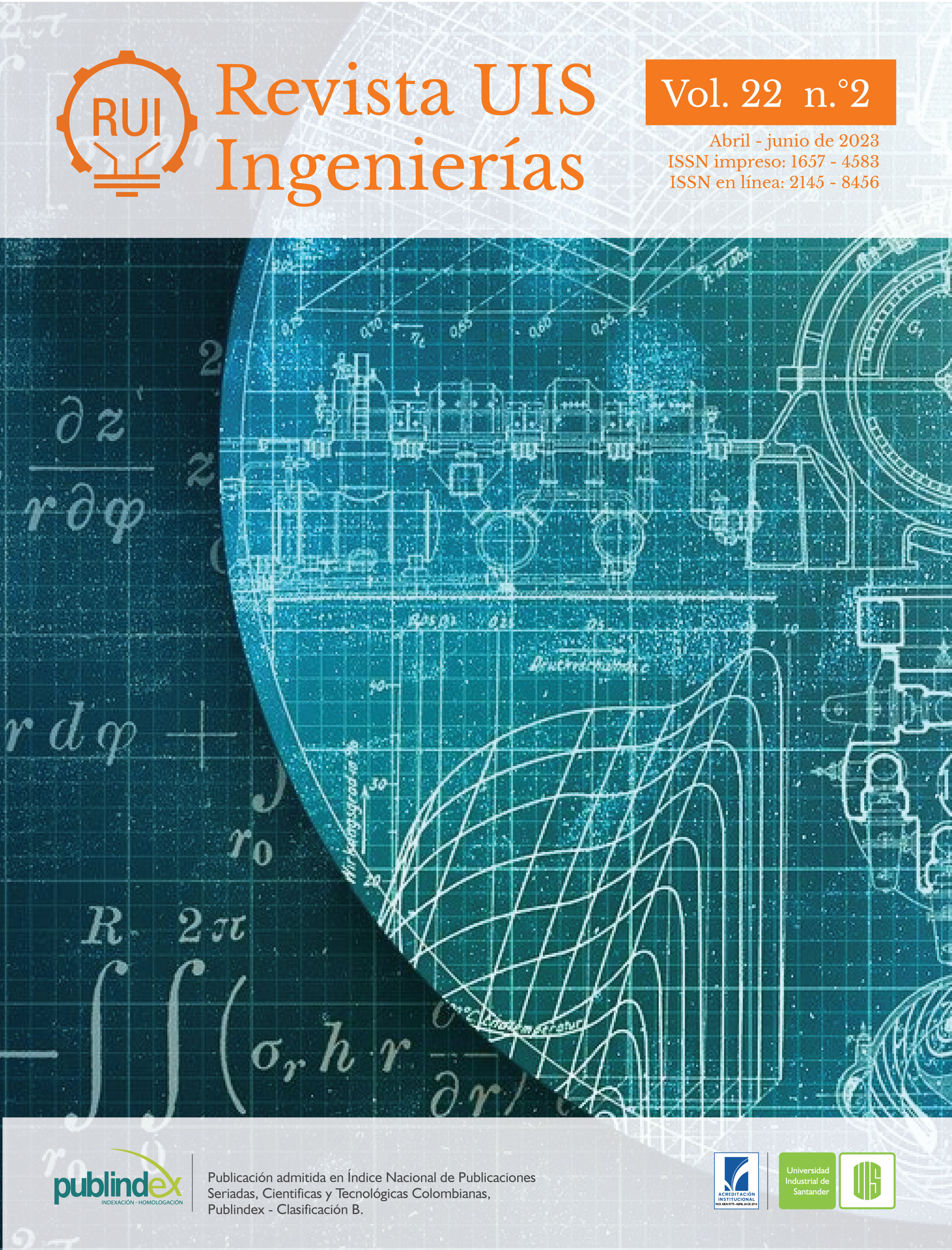Numerical evaluation of stiffness and toughness in bio-inspired composite materials
Published 2023-05-16
Keywords
- biomimetics,
- composite materials,
- hierarchical structure,
- continuous fibers,
- mechanical properties
- stiffness,
- toughness ...More
How to Cite
Copyright (c) 2023 Revista UIS Ingenierías

This work is licensed under a Creative Commons Attribution-NoDerivatives 4.0 International License.
Abstract
Nature has served as inspiration for multiple areas of knowledge and development of humanity, in the case of materials, their evolutionary process of millions of years has managed to obtain a good compatibility between the mechanical properties of rigidity and toughness, something that is complicated in conventional engineering materials, because these properties behave inversely proportional to each other. It has been established that the formation of hierarchical structures is one of the features that nature uses, ranging from the micrometric scale to the macro scale, with this type of organization, nature has improved various properties, depending on the need to be resolved, the environment in which it is located and the available materials. Helicoidal structures are one of these types of structures and they are present in fish scales, mollusk shells, exoskeletons, etc., these structures provide protection and good mechanical properties and resistance to penetration, impact and fracture. For this reason, it is intended to carry out a numerical study of materials composed of continuous fibers using different constitutive models (lineal and bilinear plasticity) for the matrix (soft) and fibers (stiff) and observe how the variation of the pattern used and the angle of rotation of the fibers affect the overall stiffness and toughness of the material.
Downloads
References
- Y. Yang et al., “Recent Progress in Biomimetic Additive Manufacturing Technology: From Materials to Functional Structures,” Adv. Mater., vol. 30, no. 36, p. 1706539, Sep. 2018, doi: https://doi.org/10.1002/ADMA.201706539
- N. S. Ha, G. Lu, “A review of recent research on bio-inspired structures and materials for energy absorption applications,” Compos. Part B Eng., vol. 181, no. September 2019, p. 107496, 2020, doi: https://doi.org/10.1016/j.compositesb.2019.107496
- B. Bhushan, “Biomimetics: lessons from nature-an overview,” Philos. Trans. A. Math. Phys. Eng. Sci., vol. 367, no. 1893, pp. 1445–86, 2009, doi: https://doi.org/10.1098/rsta.2009.0011
- T. Ikoma, H. Kobayashi, J. Tanaka, D. Walsh, S. Mann, “Microstructure, mechanical, and biomimetic properties of fish scales from Pagrus major,” J. Struct. Biol., vol. 142, no. 3, pp. 327–333, 2003, doi: https://doi.org/10.1016/S1047-8477(03)00053-4
- M. A. Pérez, M. Sánchez, “Fundamentos de la mecánica de los materiales compuestos,” in Aplicaciones avanzadas de los materiales compuestos en la obra civil y la edificación, OmniaScience, 2014, pp. 19–50, doi: https://doi.org/10.3926/oms.200
- L. S. Arias, L. Vanegas, “Falla de los materiales compuestos laminados,” Sci. Tech., no. 25, pp. 113–118, 2004.
- N. Du, Z. Yang, X. Y. Liu, Y. Li, H. Y. Xu, “Structural Origin of the Strain-Hardening of Spider Silk,” Adv. Funct. Mater., vol. 21, no. 4, pp. 772–778, 2011, doi: https://doi.org/10.1002/ADFM.201001397
- A. Zaheri et al., “Revealing the Mechanics of Helicoidal Composites through Additive Manufacturing and Beetle Developmental Stage Analysis,” Adv. Funct. Mater., vol. 28, no. 33, p. 1803073, 2018, doi: https://doi.org/10.1002/ADFM.201803073
- A. Tasdemirci et al., “Crushing behavior and energy absorption performance of a bio-inspired metallic structure: Experimental and numerical study,” Thin-Walled Struct., vol. 131, no. July, pp. 547–555, 2018, doi: https://doi.org/10.1016/j.tws.2018.07.051
- B. Kumbasa, “Progressive Interlaminar Failure Analysis in Composite Missile Structures,” 2016. [En línea]. Disponible en: https://etd.lib.metu.edu.tr/upload/12620477/index.pdf
- K. Wu et al., “Discontinuous fibrous Bouligand architecture enabling formidable fracture resistance with crack orientation insensitivity,” Proc. Natl. Acad. Sci. U. S. A., vol. 27, no. 117, p. 8, 2020, doi: https://doi.org/10.1073/pnas.2000639117
- R. Kienzler, I. Ott, H. Altenbach, Eds., Theories of Plates and Shells, vol. 16. Springer Berlin Heidelberg, 2004.
- J. N. Reddy, “Theory and analysis of laminated composite plates,” in Mechanics of Composite Materials and Structures, 1999, pp. 1–79, doi: https://doi.org/10.1007/978-94-011-4489-6_1
- P.-Y. Y. Chen, J. McKittrick, M. A. A. Meyers, “Biological materials: Functional adaptations and bioinspired designs,” Prog. Mater. Sci., vol. 57, no. 8, pp. 1492–1704, 2012, doi: https://doi.org/10.1016/j.pmatsci.2012.03.001
- D. Wang, A. Zaheri, B. Russell, H. Espinosa, P. Zavattieri, “Fiber reorientation in hybrid helicoidal composites,” J. Mech. Behav. Biomed. Mater., vol. 110, p. 103914, 2020, doi: https://doi.org/10.1016/j.jmbbm.2020.103914
- A. Zaheri et al., “Revealing the Mechanics of Helicoidal Composites through Additive Manufacturing and Beetle Developmental Stage Analysis,” Adv. Funct. Mater., vol. 28, no. 33, pp. 1–11, 2018, doi: https://doi.org/10.1002/adfm.201803073
- B. Zelazny, A. C. Neville, “Quantitative studies on fibril orientation in beetle endocuticle,” J. Insect Physiol., vol. 18, no. 11, pp. 2095–2121, 1972, doi: https://doi.org/10.1016/0022-1910(72)90243-0
- A. V. Melnik, A. Goriely, “Dynamic fiber reorientation in a fiber-reinforced hyperelastic material,” Math. Mech. Solids, vol. 18, no. 6, pp. 634–648, 2013, doi: https://doi.org/10.1177/1081286513485773
- E. Castillo-Sebastián, “Análisis de criterios de fallo para materiales compuestos,” trabajo de fin de grado, Universidad Politécnica de Cataluña, 2016. [En línea]. Disponible en: https://riunet.upv.es/bitstream/handle/10251/72577/CASTILLO%20-%20An%C3%A1lisis%20de%20criterios%20de%20fallo%20para%20materiales%20compuestos.pdf?sequence=4

